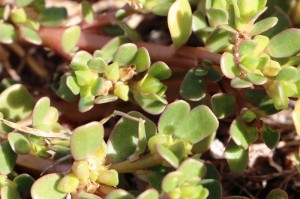Purslane Wonder Weed
 I had noticed this plant growing near the olive trees. It didn’t look like a noxious weed, so I left it growing, I found out today it is Purslane, or pigweed. I have pretty much summarised the wikipedia entry as it seems to be a wonder weed.
I had noticed this plant growing near the olive trees. It didn’t look like a noxious weed, so I left it growing, I found out today it is Purslane, or pigweed. I have pretty much summarised the wikipedia entry as it seems to be a wonder weed.
It is eaten throughout much of Europe, the middle east, Asia, and Mexico. The stems, leaves and flower buds are all edible. Purslane may be used fresh as a salad, stir-fried, or cooked as spinach is, and because of its mucilaginous quality it also is suitable for soups and stews. Australian Aborigines use the seeds to make seedcakes. Greeks, who call it andrakla or glystrida, fry the leaves and the stems with feta cheese, tomato, onion, garlic, oregano, and olive oil, add it in salads, boil it or add to casseroled chicken. In Turkey, besides being used in salads and in baked pastries, it is cooked as a vegetable similar to spinach.
Purslane contains more omega-3 fatty acids (alpha-linolenic acid in particular) than any other leafy vegetable plant. Studies have found that Purslane has 0.01 mg/g of eicosapentaenoic acid (EPA). This is an extraordinary amount of EPA for a land-based vegetable source. EPA is an Omega-3 fatty acid found mostly in fish, some algae, and flax seeds. It also contains vitamins (mainly vitamin A, vitamin C, Vitamin E (alpha-tocopherol) and some vitamin B and carotenoids), as well as dietary minerals, such as magnesium, calcium, potassium, and iron. Also present are two types of betalain alkaloid pigments, the reddish betacyanins (visible in the colouration of the stems) and the yellow betaxanthins (noticeable in the flowers and in the slight yellowish cast of the leaves). Both of these pigment types are potent antioxidants.
If water stressed it switches to photosynthesis using Crassulacean acid metabolism, at night its leaves trap carbon dioxide, which is converted into malic acid, and, in the day, the malic acid is converted into glucose. If harvested in the early morning, the leaves have ten times the malic acid content as when harvested in the late afternoon, and thus have a significantly more tangy taste.
In traditional Chinese medicine it is known as Ma Chi Xian its active constituents include: noradrenaline, calcium salts, dopamine, malic acid, citric acid, glutamic acid, asparagic acid, nicotinic acid, alanine, glucose, fructose, and sucrose.
Its leaves are used to treat insect or snake bites on the skin, boils, sores, pain from bee stings, bacillary dysentery, diarrhea, hemorrhoids, postpartum bleeding, and intestinal bleeding.
In antiquity, its healing properties were thought so reliable that Pliny the Elder advised wearing the plant as an amulet to expel all evil.

Facebook